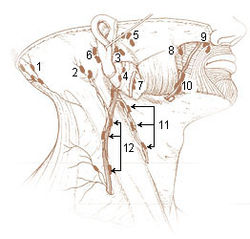| Preauricular deep parotid lymph nodes | |
|---|---|
 Lymph nodes at Surface: 1. Occipital (retroauricular) 2. Mastoid 3. Superficial Parotid 4. Deep Parotid 5. Preauricular 6. Infraauricular 7. Intraglandular parotid Facial Lymph Nodes: 8. Buccinator 9. Nasolabial 10. Mandibular 11. Anterior Cervical (Superficial jugular) 12. Superficial Cervical (External jugular) | |
| Details | |
| System | Lymphatic system |
| Drains from | Parotid gland |
| Drains to | Superior deep cervical lymph nodes |
| Identifiers | |
| Latin | nodi lymphoidei parotidei profundi preauriculares |
| Anatomical terminology | |
The preauricular deep parotid lymph nodes (anterior auricular glands or preauricular glands), from one to three in number, lie immediately in front of the tragus.
Their afferents drain multiple surfaces, most of which are lateral in origin. A specific example would be the lateral portions of the eye's bulbar and palpebral conjunctiva as well as the skin adjacent to the ear within the temporal region. The efferents of these nodes pass to the superior deep cervical glands.
The preauricular nodes glands will present with marked swelling in viral conjunctivitis.[1]
References
[edit]- ^ MD, Timothy Root (2007-12-13). "Chapter 5: Eye infections - TimRoot.com". TimRoot.com. Retrieved 2018-10-21.
![]() This article incorporates text in the public domain from page 693 of the 20th edition of Gray's Anatomy (1918)
This article incorporates text in the public domain from page 693 of the 20th edition of Gray's Anatomy (1918)
External links
[edit]- Image at umich.edu - must rollover bad link
- Diagram at Baylor College of Medicine bad link
- Lymphadenopathy and Malignancy article - American Family Physician journal
Well, that’s interesting to know that Psilotum nudum are known as whisk ferns. Psilotum nudum is the commoner species of the two. While the P. flaccidum is a rare species and is found in the tropical islands. Both the species are usually epiphytic in habit and grow upon tree ferns. These species may also be terrestrial and grow in humus or in the crevices of the rocks.
View the detailed Guide of Psilotum nudum: Detailed Study Of Psilotum Nudum (Whisk Fern), Classification, Anatomy, Reproduction